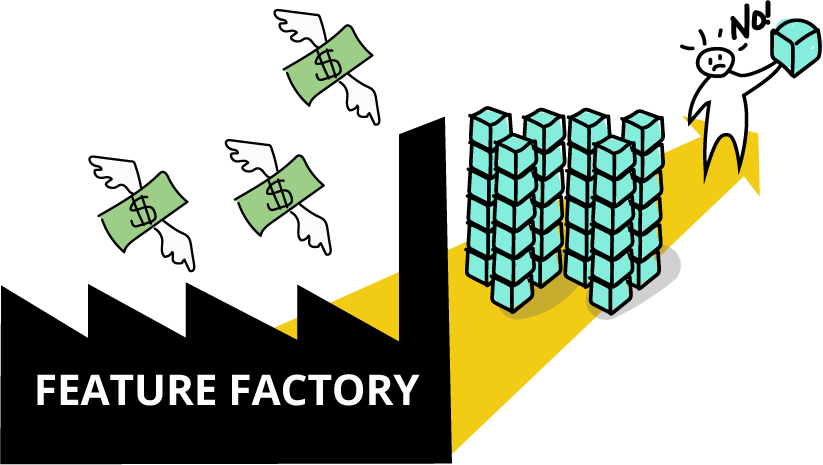Do you recognize any of the following in your company?
- IT/Tech is measured by how many features they’re pushing out to the market, whereas marketing is measured by how much they sell.
- The feature team has become a feature factory that produces features, but is unsure of the value for the customers.
- Your company’s business is not good and the results are falling.
Then, you probably need to change a few things to make your organization successful. Let me take you through some of the most common problems in many organizations today.

The Feature Team – the Producers
A feature team is a team that produces features. We know from research that about 70% of all features being produced are not used by customers. Don’t get me wrong, it is necessary to build teams consisting of all the competencies needed, but why call them a feature team? Maybe a better word could be “business team” which indicates the importance of having a business focus while still having all the necessary competencies to build something valuable for the customer. Or – a “Lean team”. I’m fine with just any more suitable name that is not confusing.

What is a Feature Factory?
A feature factory is a company that produces features without knowing if they are going to make an impact on the customer. The focus of a feature factory is on producing features, not delivering value. In a feature factory, the sales teams are trying to sell all sorts of stuff to increase their goals without anchoring what they are promising with developers (or any other part of the company…). And I’m not blaming them! This behavior reflects exactly on how the company is set up. Often with silos and conflicting goals.
Feature Factories naturally arise when teams are being measured on how many features they produce.
I have seen this over and over again. What you are measured on becomes your focus. And if sales is being measured on how much they sell, the developing teams need to produce. And fast! But, as we all know, things will be impossible to sell after a while if the customers don’t see the value in the products you produce. And, solutions that are not solving user problems will not increase sales in the end.

Be as One
We need to STOP focusing on system components and organize around customer value instead! We need to understand that IT/Tech is NOT a separate “thing” in the company. Stop measuring the wrong things and stop having different measurements for different apartments in need of cooperate. Instead, when you have joint measurements for the company you make people work together towards common goals. Also, when you involve the customers in development, you avoid guessing what they need and risk sending money down the drain. And then you continue to tweak things until the customer is satisfied. This way you can be sure that you’re delivering VALUE.
Customer Focus to Ensure Value
Having the customer as the starting point in everything that is produced should be a key part of your customer-centric strategy, as well as experimenting and getting feedback from the customer to be able to build the right solution. Organize team around customer journey and around products (what customer buys) and add the teams needed to support them. Don’t specify in advance – use Design Thinking instead and involve the users in the process to get knowledge about their behavior and needs they have. And in doing so, you will get so much better business results!

- Empathize with the customer. Do research with the customer, stakeholders, and other people needed outside the team to be able to get the whole picture.
- Get insights, define by taking all the research your team did, and understand where your user’s real problems are.
- Ideate ideas, let them be crazy and creative – to be able to find the right solution.
- Prototype it, so customers and stakeholders can understand it, give feedback, and test if it works for them.
- Then put the vision into effect, implement the solution, and evaluate the result.
When working this way, you can eliminate ideas that don’t solve customers’ problems, instead of wasting time building them. Why be a feature factory when customers don’t want or use them?

Working in a customer centric way will also enable faster deliveries and shorter feedback cycles, as well as more business value in a shorter time frame. It is also important to enable a pull-based system that enables a shared understanding on what is important to get knowledge about, or what to build. Show ongoing work, and enable new learnings to impact the planning. Successful companies have found that it’s better to change the plan than to waste a lot of money on the wrong solution. This might sound obvious, yet a lot of companies are NOT changing the plan and try to specify things in advance. One of the most common things in companies is having different ways of measuring and different measurements. Not being aligned is costing companies today millions each year. So instead: bring them together!
Big thanks to Mia Kolmodin for the graphics <3


